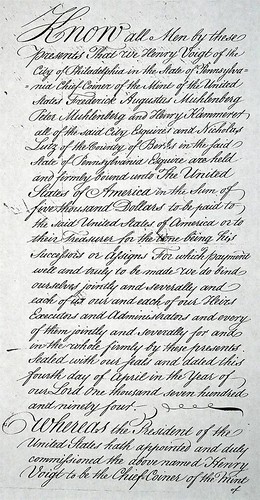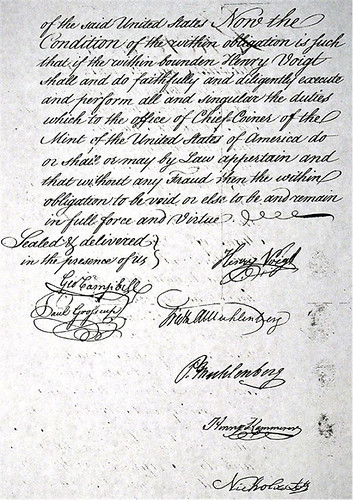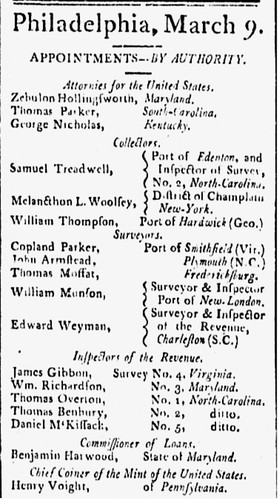
PREV ARTICLE
NEXT ARTICLE
FULL ISSUE
PREV FULL ISSUE
HENRY VOIGT’S SURETY BOND
I was unfortunately unable to attend David Finkelstein's presentation at last month's ANA World's Fair of Money. But
here's a glimpse into some of his great research into the first U.S. Mint, where one of his discoveries corrects a long-held
misconception about who posted the surety bond for Henry Voigt. Since Mint employees worked with valuable materials they were required to
make available a pledge that would reimburse the Mint should Voigt steal or lose Mint property. This is a high bar for holding a job. In
Voigt's case a "surety bond" was posted by friends pledging financial responsibility on Voigt's behalf. Here's his
article as published in the John Reich Newsletter. NOTE: As always, you can click on an image to see a larger version on our Flickr
archive. -Editor
 
As a researcher of the technology, processes, implementation standards, and people that worked at the first United States Mint, I have read many publications on a wide variety of Mint related subjects. The general belief, without any supporting evidence, has long been that David Rittenhouse (the first Director of the Mint) posted the surety bond for Henry Voigt (the first Chief Coiner of the Mint). We now know that David Rittenhouse did not post Voigt’s surety bond. Voigt’s surety bond has been found, stored among Treasury Department documents for the last 221 years. It is being presented in this article for the first time ever.
The Mint & Coinage Act of April 2, 1792 required the Chief Coiner to be bound to the United States of America and to post a surety bond of $10,000.00. This sum was too large for Voigt and he was unable to post his bond. This issue was one of the impediments to converting silver and gold bullion into coins during 1793 and most of 1794. Without the required bond in place, Voigt was unable to receive custody of silver and gold bullion. As a result, the employees in his department could not roll the bullion into strips, punch planchets out of the strips, process the planchets through the Castaing Machine (if required), and strike the planchets into United States money. On December 30, 1793, Secretary of State Thomas Jefferson wrote a two page letter to President Washington identifying issues with The Mint & Coinage Act that prevented the Mint from accepting bullion deposits, and striking silver and gold coins. Per the first sentence, Jefferson’s letter was based on information provided by Director of the Mint David Rittenhouse: “I am informed, by the Director of the Mint, that an impediment has arisen to the coinage of the precious Metals, which it is my Duty to lay before you”. Jefferson’s letter also included the following passages: “It will be recollected… That thereupon, our minister at London, according to the instructions he had received, endeavored to procure, there, a Chief Coiner and Assayer; That, as to the latter, he succeeded, sending over a Mr Albion Coxe, for that Office, but that he could procure no person, there, more qualified to discharge the duties of chief Coiner, than might be had here; and therefore did not engage one. The Duties of this last Office, have consequently been hitherto performed, and well performed by Henry Voight, an Artist of the United States: but the law requiring these Officers to give a security in the sum of 10,000 dollars each, neither is able to do it”. “… The other alternative would be to lessen the Securityship in money, and to confide that it will be supplied by the vigilance of the Director, …” On December 31, 1793, President Washington forwarded Jefferson’s letter to Congress. On February 18, 1794 the Senate passed a bill entitled "an act in alteration of the act establishing a mint and regulating the coins of the United States” or The Alteration of the Mint Act. The bill was approved by the House of Representatives on February 25th and signed into law by President Washington on March 3, 1794. Per Section 2 of The Alteration of the Mint Act, the Chief Coiner’s surety bond was reduced from $10,000.00 to $5,000.00: “And be it further enacted, That the assayer and chief coiner of the mint previous to entering upon the execution of their respective offices shall each become bound to the United States of America with one or more sureties to the satisfaction of the Secretary of the Treasury, the said assayer in the sum of one thousand dollars and the said chief coiner in the sum of five thousand dollars, …“ Recall that in his December 30, 1793 letter, Thomas Jefferson stated, “The other alternative would be to lessen the Securityship in money, and to confide that it will be supplied by the vigilance of the Director”. If one were to ignore the words “the vigilance of”, the phrase would become “that it will be supplied by the Director”. I have found no other contemporary document that references Henry Voigt’s surety bond, therefore I believe that Thomas Jefferson’s statement may have been misinterpreted, resulting in the belief that David Rittenhouse posted Voigt’s surety bond. The fact is, Henry Voigt’s surety bond was posted on April 4, 1794 by Frederick Augustus Muhlenberg, Peter Muhlenberg, Henry Kammerer, and Nicholas Lutz. When Voigt’s surety bond was posted:
Accurate information regarding Henry Voigt’s surety bond is now correctly documented for future generations of numismatists and numismatic researchers. References 1. American State Papers; The Mint & Coinage Act of April 2, 1792 and The Alteration of the Mint Act of March 3, 1794. 2. Founders Online; www.founders.archives.gov, The Thomas Jefferson Papers. 3. National Archives and Records Administration; Treasury Department, Records of the Bureau of Accounts. THE BOOK BAZARREWayne Homren, Editor The Numismatic Bibliomania Society is a non-profit organization promoting numismatic literature. See our web site at coinbooks.org. To submit items for publication in The E-Sylum, write to the Editor at this address: whomren@gmail.com To subscribe go to: https://my.binhost.com/lists/listinfo/esylum All Rights Reserved. NBS Home Page Contact the NBS webmaster 
|
